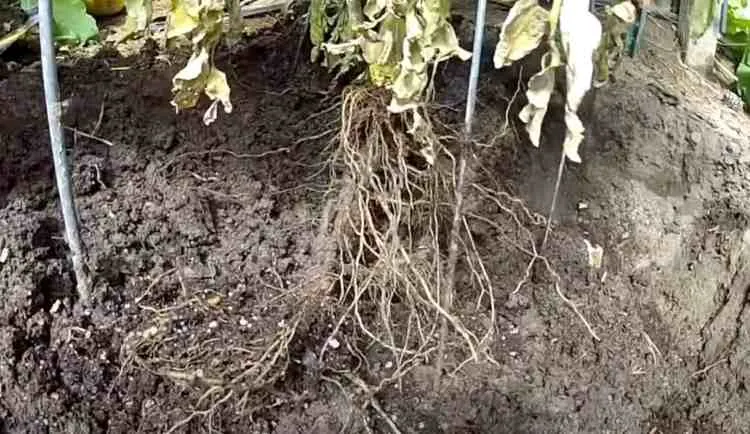How deep do tomato plant roots get?

If you’re planning to grow your tomato plants in containers or a raised bed garden, or if you need to move your tomato plants and want to do so without damaging their roots, you’ll need to know how far the roots of tomato plants extend into the soil. Continue reading to find out how deep the roots of your tomato plants may grow.

Contents
How Deep Does a Tomato Plant’s Root System Go?
Tomatoes have a taproot system because they are dicots, or plants with two embryonic leaves (called cotyledons). This contrasts with the fibrous root system of monocots, plants with just one embryonic leaf. A fibrous root system is what most people envision when they think of plant roots: a network of many tiny, branching roots that resemble the limbs of a tree turned upside down.
A taproot system, on the other hand, includes some of those little, spreading roots, but the taproot is right in the core. The taproot is bigger than the other roots that support it, and it digs deep into the soil to absorb huge amounts of nourishment and water. A taproot will tunnel straight down into the earth if there are no barriers in its path.
A tomato plant’s taproot may grow up to three feet into the earth. Long taproots like this are especially prone to forming when the plant needs to cover more ground in order to get the hydration and nutrients it requires to grow healthy and strong. That’s why tomato plants grown in poor, loose soils have the longest taproots.
What Factors Affect the Depth of a Tomato Plant’s Roots?
Of course, not all tomato plants are made equal. Some plants have robust taproots that provide nutrients and water to the plant. Some tomato plants have weaker root systems, with taproots that do not extend as deep into the earth. These tomato varieties will depend more on the gardener to supply the plant with the water it needs or to provide fertilizer to round out its nutritional requirements. Several variables will also impact the depth of a tomato plant’s root system.
When a tomato plant is cultivated in a container or raised bed, the depth of the soil accessible to it naturally influences how deep into the earth its taproot may extend. When the taproot is prevented from tunneling down into the soil by a container or the bottom of a raised bed planter, it’s common for the taproot to grow in circles on the bottom surface of the container or planter.
Even if the taproot encircling the same location numerous times will not provide any more moisture or nutrients to the tomato plant, the plant is naturally forced to continue expanding the taproot. When it’s possible to breach the boundary at the bottom of a raised bed planter, tomato plants have been known to continue tunneling down into the soil below in their search for nutrition.
The type of soil in which a tomato plant is growing will also influence how far its taproot extends. As previously stated, the highest taproot length is seen in poor or loose soils. If the soil in your garden is extremely dense and compact, your tomato plant may not be able to make its way far into the depths of the soil. The taproot will continue to develop laterally in this circumstance, just as it does in a container.
Another factor influencing the development of your tomato plant’s root system is the quality of your soil. When the soil is especially rich and fertile, your tomato plant doesn’t really need to extend its taproot far down into the soil in order to acquire the nutrients it needs to support the plant’s growth. The root system will continue grow under these conditions, but it will take on a different appearance.
When the soil is extremely healthy, the roots do not extend as much and create a thicker, more compact structure. The plant will concentrate more energy to growing secondary roots that branch out from the taproot, but the taproot itself will be less developed as a result. Tomato plants grown in this soil will have a broader root system that does not extend as deep into the earth as a tomato plant’s taproot would ordinarily.
For growing tomato plants, some gardeners adopt a method that includes partly burying the stem under the soil’s surface. Since tomato plants can produce roots from their stems, this method works. When this strategy is used, the increased root development capability implies that the tomato plant does not have to rely as much on its taproot since it has the support of these extra roots from the stem. As a result, the taproot may not penetrate as deeply into the soil in certain circumstances.
You now know how far a tomato plant’s taproot generally reaches under the earth. You’ve also learned about the numerous elements that might impact how successfully your tomato plants’ root systems grow. Now that you’ve read this article, you should be prepared to transplant tomatoes without cutting into their roots or to provide them with containers and raised beds that give their taproots plenty of room to grow.
Learn More About Tomato Roots
Related Questions
-
How deep should soil be for tomato plants?
For each plant, dig a 12-inch-deep hole and put a handful of excellent fertilizer into it. (Heyming also likes to add a banana peel and the shells from one egg into the bottom of the hole to provide extra nutrients for the roots later in the season.) Remove the leaves from the lowest part of the main stem.
-
Is 12 inches deep enough for tomatoes?
Tomatoes produce extra roots along the stem when planted deeply. The depth of your raised bed should be at least 12″. The more roots form along the stem, the easier it will be for the tomato plants to absorb moisture from the soil in your raised bed.
-
How deep should tomato roots raised beds be?
Tomatoes, which thrive from deep planting, need 24 to 36 inches (60 to 90 cm) of depth for their roots to flourish. However, if your raised bed is about a foot high, the growth of the plant may simply be slightly stunted.
-
How many tomato plants in a 2×4 raised bed?
Two to three tomato plants may be grown in a single row in a raised bed 2 feet by 4 feet. Because of this, there will be sufficient space for each tomato to grow vertically for around 1.5 feet and horizontally for approximately 2 feet.





